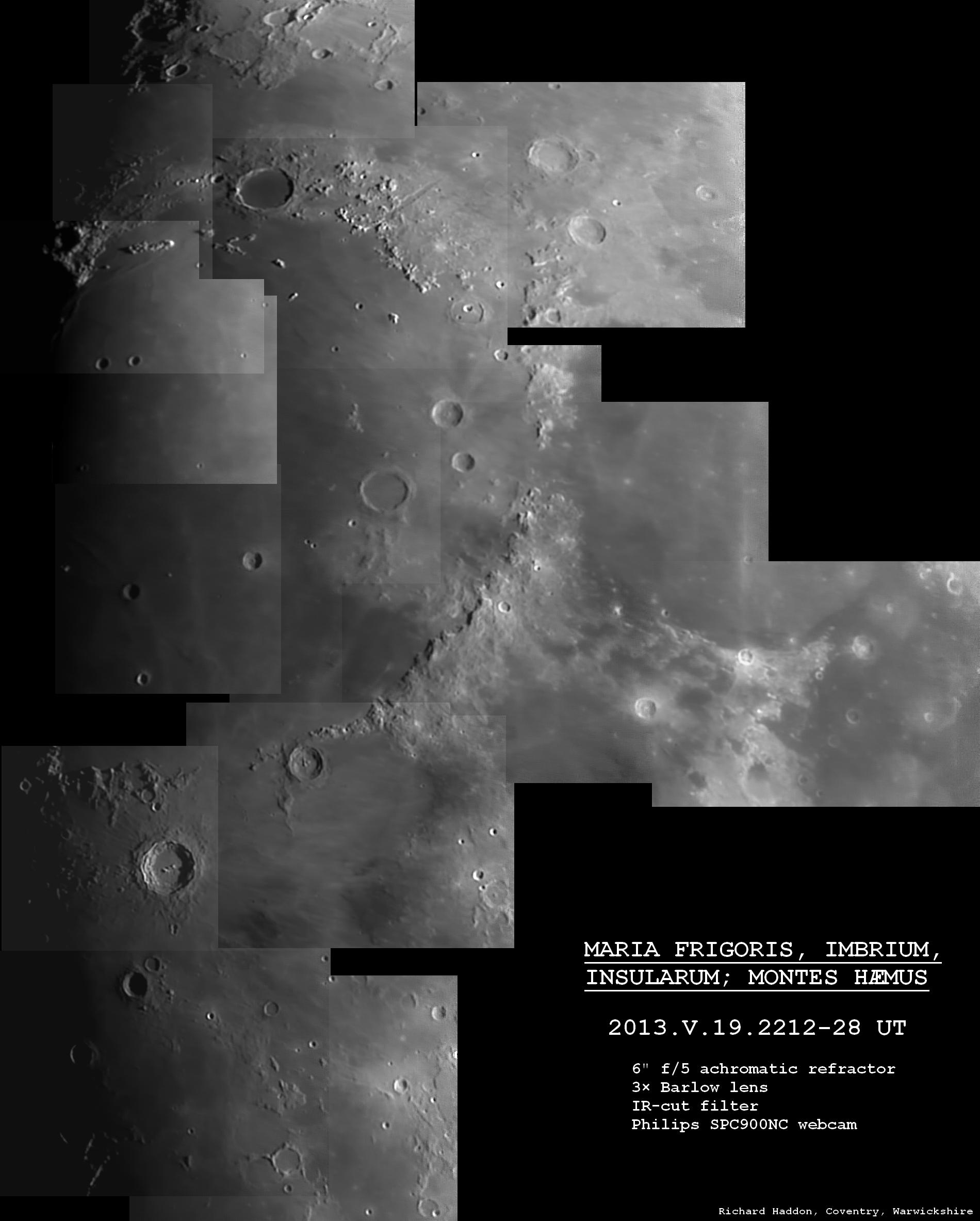
'How sweet the moonlight sleeps upon this bank!
Here we will sit, and let the sounds of music
Creep in our ears; soft stillness and the night
Become the touches of sweet harmony.
Sit, Jessica; look, how the floor of heaven
Is thick inlaid with patines of bright gold:
There's not the smallest orb which thou behold'st
But in his motion like an angel sings
Still quiring to the young-eyed cherubins;
Such harmony is in immortal souls;
But whilst this muddy vesture of decay
Doth grossly close it in, we cannot hear it.'
William Shakespeare, The Merchant of Venice (1596-8) Act V, Scene I
* * *
'Wanna cry, wanna croon.
Wanna laugh like a loon.
It's that Old Devil Moon in your eyes.'
Yip Harburg, Finian's Rainbow (1946) 'Old Devil Moon' (music by Burton Lane)
* * *
'Hey! There is orange soil! 'exchange between Jack Schmitt and Gene Cernan whilst prospecting the Lunar Taurus-Littrow valley on Apollo XVII (1972)
A selection of my observations of the Moon.
Sometimes the Earth-Moon system is considered to be a double planet; the Moon exerts a gravitational attraction over the Earth that visibly moves the planet towards her, and both planets orbit a common centre of gravity. However, this centre of gravity is well below Earth's surface. As an independent planet, the Moon is more properly given her Latin name like other planets: 'Luna'.
Observation #323B, 2013.V.19
A good-sized montage taking in some of the Moon's most famous features. 'The Monarch of the Moon', Copernicus, is the large crater at bottom left, with the Carpathian Mountains above in morning Sunshine. Copernicus leads via the smaller crater Eratosthenes at two o' clock to the upward-sweeping arc of the Appenine Mountains. After a break the Caucasus Mountains begin and trace a vertical. To the left of the Caucasus again are the Lunar Alps, broken by the famous Alpine valley, then the dark-floored walled plain Plato on the left. The Straight Range then the beginning of the Jura Mountains are to the left of Plato.
* * *
Observation #301-2, 2013.II.17-18
The following two photographs show the Alpine Valley under different illuminations, and were taken twenty-three hours apart, the Sun slowly rising from right of picture.
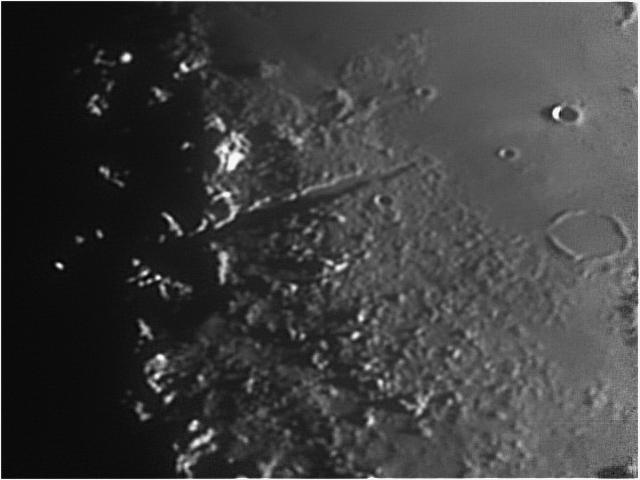
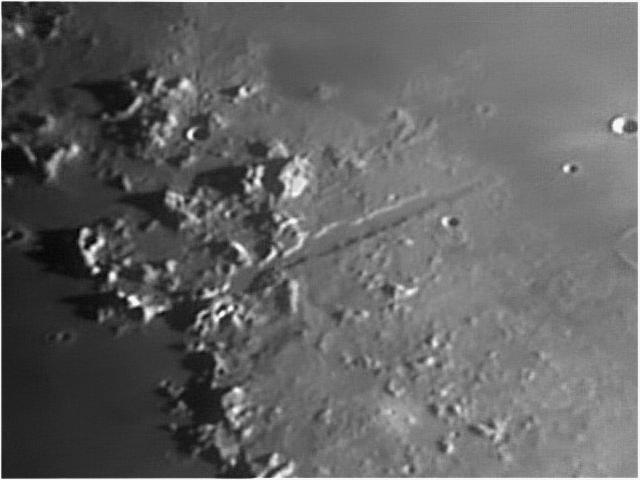
VALLIS ALPES
2013.II.17.2003 & 2013.II.18.2102 UT
* * *
Observation #301, 2013.II.17
The following gigantic montage shows as much Lunar detail as I can possibly record photographically at present.
The shot of the Alpine Valley above is reproduced here in its wider context, taking in the swathe of the Lunar Alps top left and below it the Lunar Caucasus, throwing its long impenetrable morning shadows over the sullen Imbrium plains like the fangs of some primordial monster. Top right the craters Aristoteles (60 miles across) and Eudoxus below (40 miles across) dominate the scene. Note the rows of hills radiating from Aristoteles in all directions.
* * *
Observations #291B, 292, 293A, 293B, 294, 2012.XI.3-7
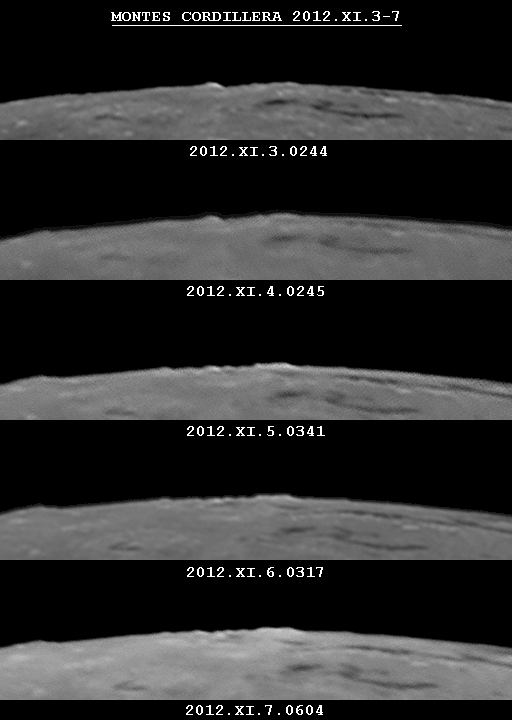
This series of photographs shows the Cordillera Mountains on the (Terrestrial) eastern Lunar limb (the left hand edge as you look at the Moon). As the days pass the Moon's rotation overtakes her orbit slightly and the mountains noticeably turn around the face of the Moon towards the observer. Unfortunately the weather was poor for most of these photographs but for the first one.
* * *
282
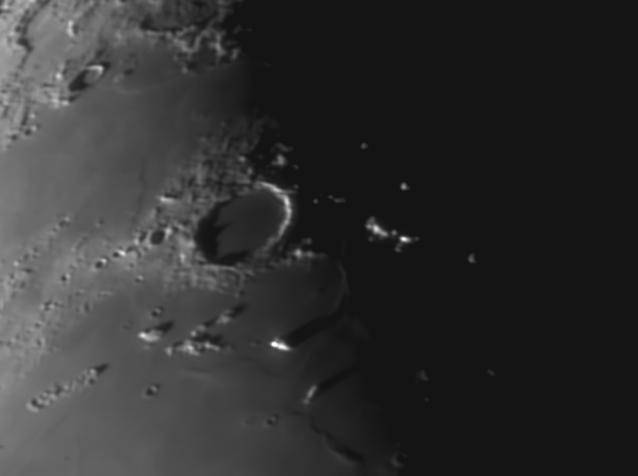
* * *
245
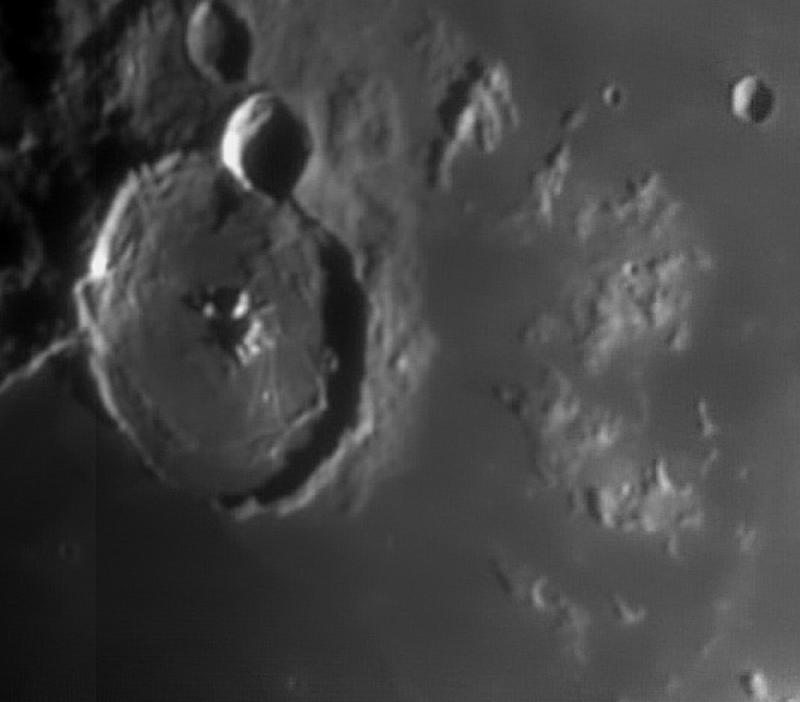
* * *
243
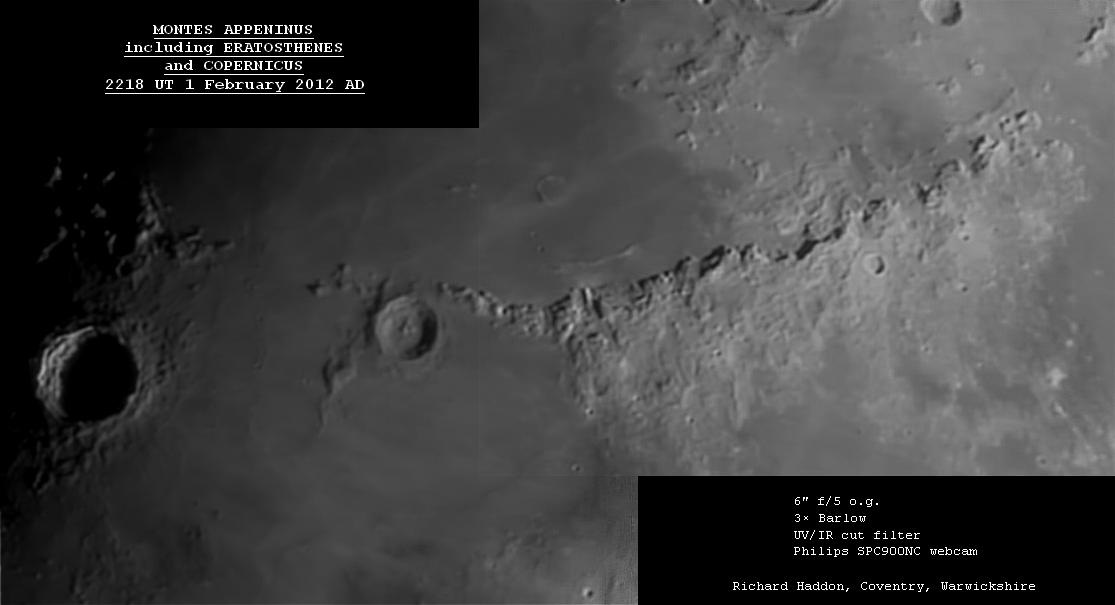
* * *
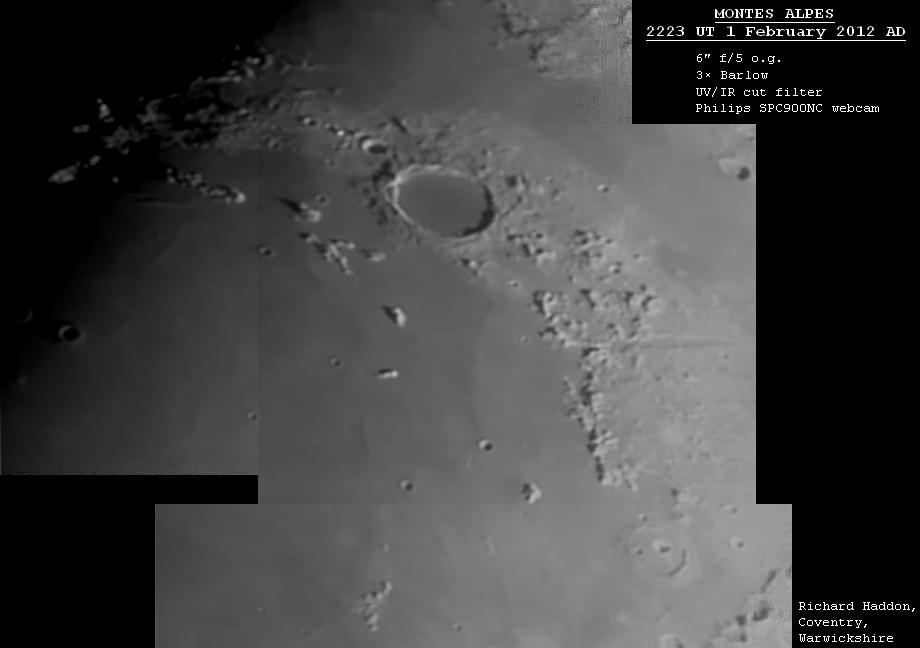
* * *
Observation #234B, 2011.XII.05 - Sinus Iridum
This is probably the finest view of dawn over the Bay of Rainbows it is possible to witness from a city. And dawn over the Bay of Rainbows is probably the finest spectacle the Moon has to offer to Earthbound observers. It's always very special. The first time I saw it was at low magnification and at first glance it looked like there was a thin silvery ring going around the Moon. That was quite a shock.
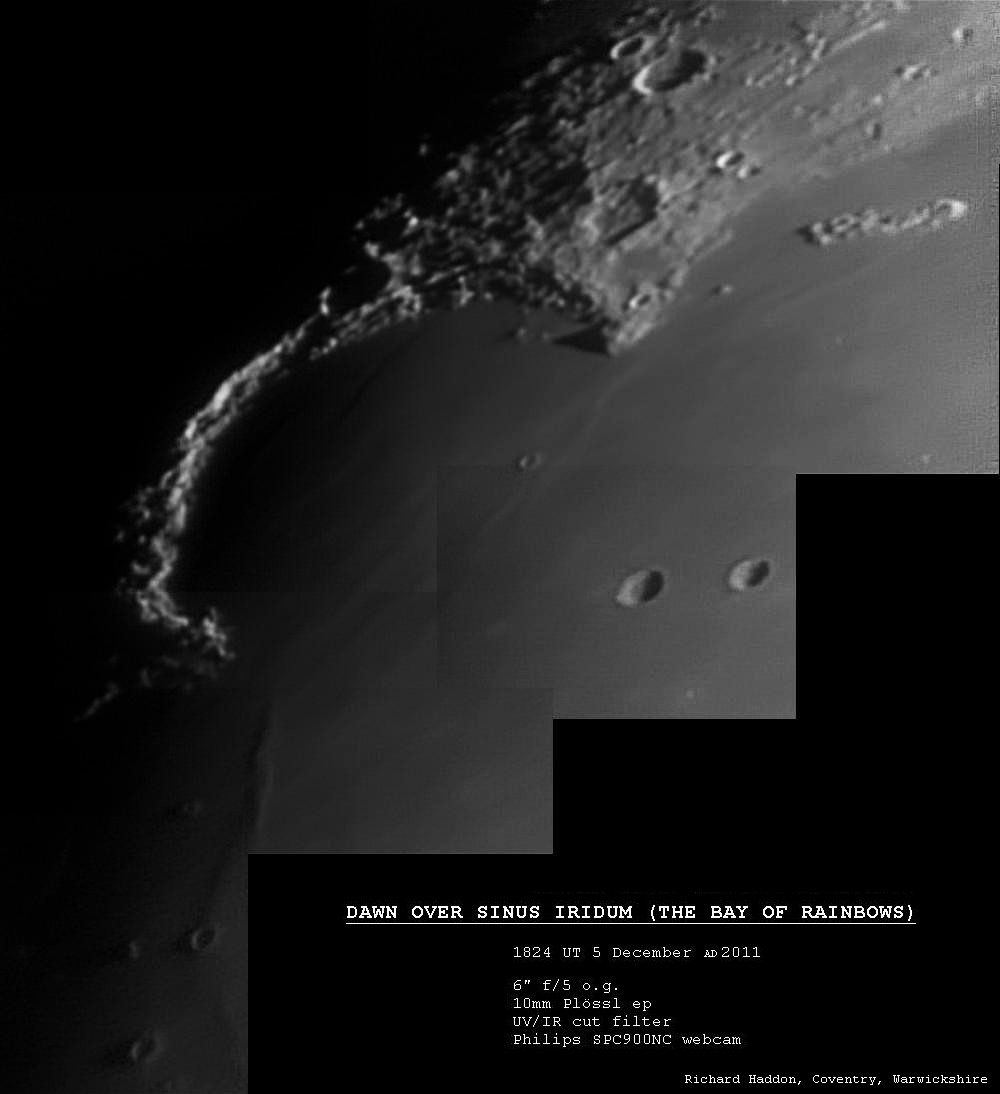
* * *
217
* * *
Observation #198, 2011.IV.12
Only the second use of my new 6" object glass, this time on the waxing Moon.
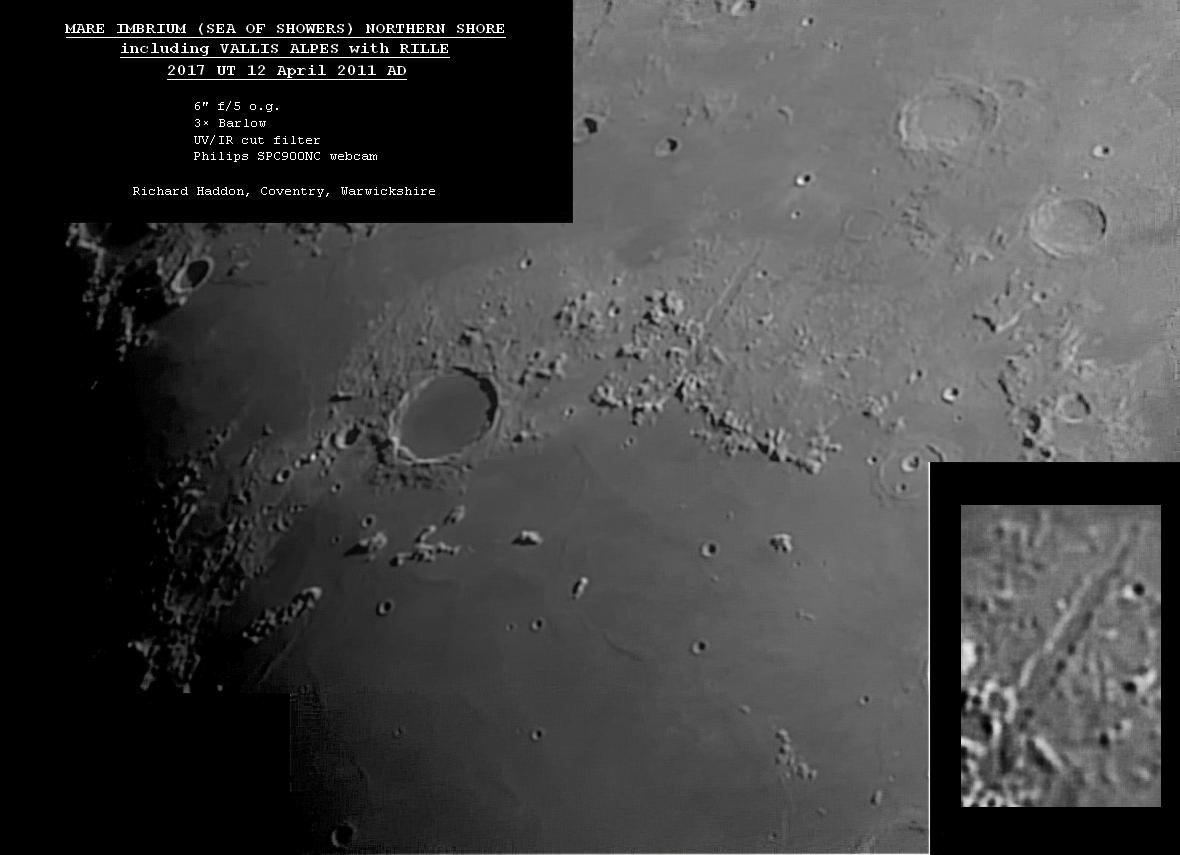
This fine composite view of the Lunar Alps bounding the northern Mare Imbrium in mid-late morning shows a wealth of detail. My primary objective though was to capture the half-mile wide rille that runs down the centre of the Alpine Valley graben. In spite of light pollution and unfavourable illumination, the sunlit wall of the rille shows up as a faint broken white line, in the centre of the obvious gash cutting into the Alps mountain range, right of the dark-floored crater Plato. Note that the detail is far clearer than in the photograph of the same area taken under Sunset lighting conditions in Observation #193 below.
* * *
Observation #183, 2010.XI.28
0307 UT
A perfectly clear night when I set up my 4" object glass over an hour previously, but some mist at this time fogging the half Moon at Last Quarter. A cold night, freezing in fact, I was still cold even with vest, long johns, shorts, two pairs of socks, track suit bottoms, heavy denim jeans, T-shirt, crew-neck jumper, cardigan, long woollen scarf, heavy woollen overcoat, two pairs of woollen gloves, astronomer's woolly pom-pom hat, British Army heavy desert combat boots, and a 1961-issue German Army sleeping bag worn on top of all. I practically needed a space suit. You should all thank me.
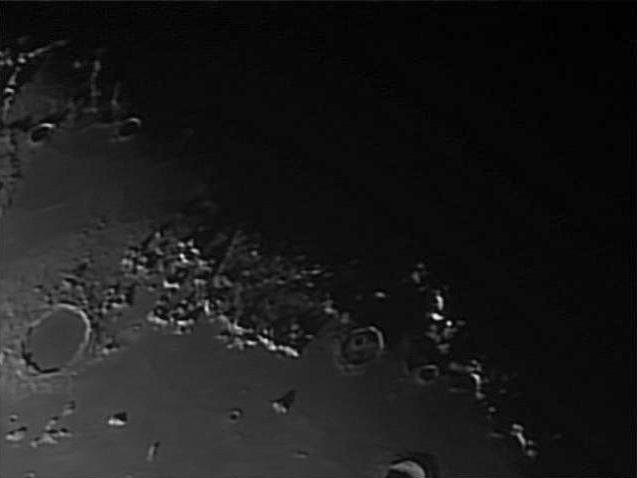
MONTES ALPES AT SUNSET
2010.XI.28.0336 UT
Here over a hundred peaks of the Lunar Alps can be seen littering the region surrounding the rift of the Alpine Valley just left of centre, whose southeastern cliffs are still in Sunlight. The dark-floored walled plain Plato, to the left of the picture, is about 60 miles wide. Also of note are the isolated peaks in the northern plains of the Mare Imbrium: Mount Pico towards the bottom left corner of the picture just below and to the right of Plato, and Mount Piton at centre bottom, casting a long crooked shadow to two o' clock. Both are in the region of 7,000 feet tall.
* * *
Observation #180, 2010.XI.16
1656-1721 UT
Captured CCD footage of the Bay of Rainbows at dawn. Had already captured this effect two years ago this January (Observation #69B) with my 8" specular, but this was the first time I had seen it since, or with my 4" object glass. Unfortunately much of the footage was marred by mist and was cloud-interrupted, so the final image is a little foggy.
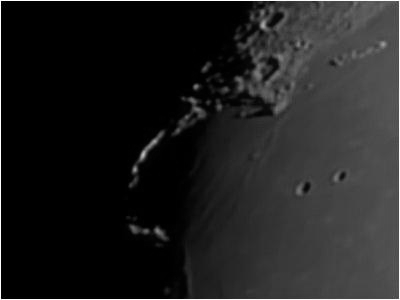
DAWN OVER SINUS IRIDUM
2010.XI.16.1710 UT
The Bay of Rainbows or Sinus Iridum is the result of a huge impact during the Moon's Upper Imbrian period (about 3,500 million years ago) at the edge of the lava sea of the Mare Imbrium to the south, itself the result of a gigantic impact during the Moon's Lower Imbrian period (about 3,800 million years ago) that formed the right eye (on the left as you look at it) of the face in the Moon. At the time of the Iridum impact the Mare Imbrium would still have been molten lava, so that whilst the northern edge of the Iridum blast basin formed the semi-circle of the Jura Mountains to the northwest, to the southeast any mountains that could have formed soon melted into the Mare Imbrium and were entirely consumed. The result today is a flat bay-like plain of basalt, some 160 miles across, north of the Mare Imbrium and 1,000 feet below the level of Imbrium, bordered to the northwest by a semi-circular mountain range (the Jura Mountains) that rises some 18,000 feet above the Iridum plain. Here the rays of the dawn Sun can be seen catching the tall peaks of the Jura Mountains still on the night side of the Moon, whilst the plain before it remains in darkness, in the celebrated 'Jewelled Handle' appearance. Note also the steep pointed shadow of the Laplace Promontory, at the rightmost edge of the mountain chain.
Sir Patrick Moore in Philip's Atlas of the Universe writes that the Sinus Iridum is perhaps the most beautiful object on the entire Moon when observed at Sunrise or Sunset, and I am inclined to agree with him whole-heartedly. Photographs don't really do it justice; Sunrise over the Bay of Rainbows seen for oneself is every bit as fantastic as it sounds.
* * *
Observation #165, 2010.VIII.30
0135 UT
Seeing lots of superb majestic features along the Lunar terminator, decided at once to image all of them.
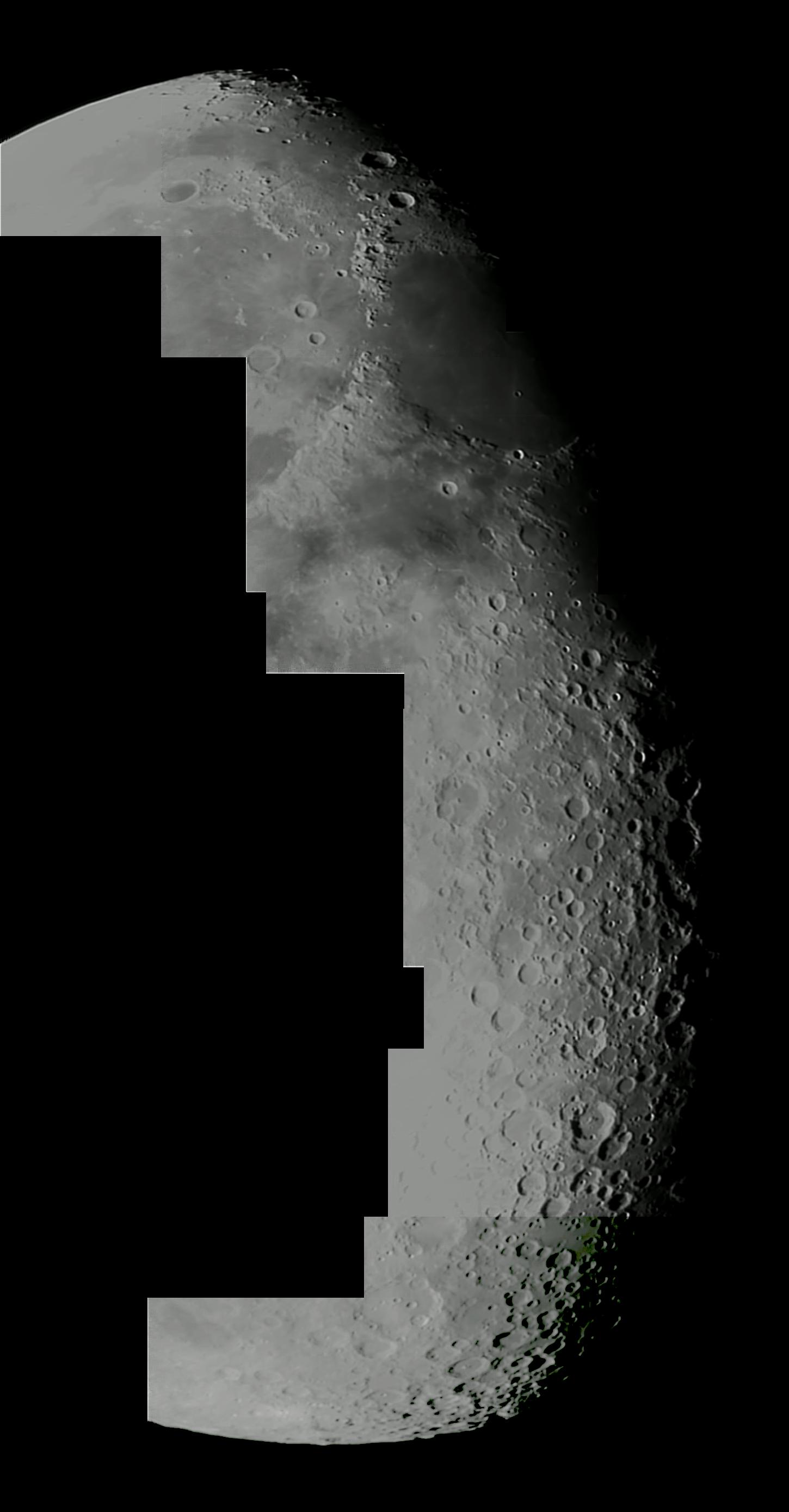
LUNAR TERMINATOR
2010.VIII.30.0135 UT
* * *
Observation #159, 2010.IV.20
A composite view of the Sea of Serenity in early Lunar morning, the Sun still rising over the Haemus mountains to the west, left of picture, and the Caucasus Mountains above them, leading to the craters Eudoxus and then Aristoteles at the very top. Note the concentric rings of ridges in the smooth Mare floor, caused by repeated lava flows from the centre of the Mare.
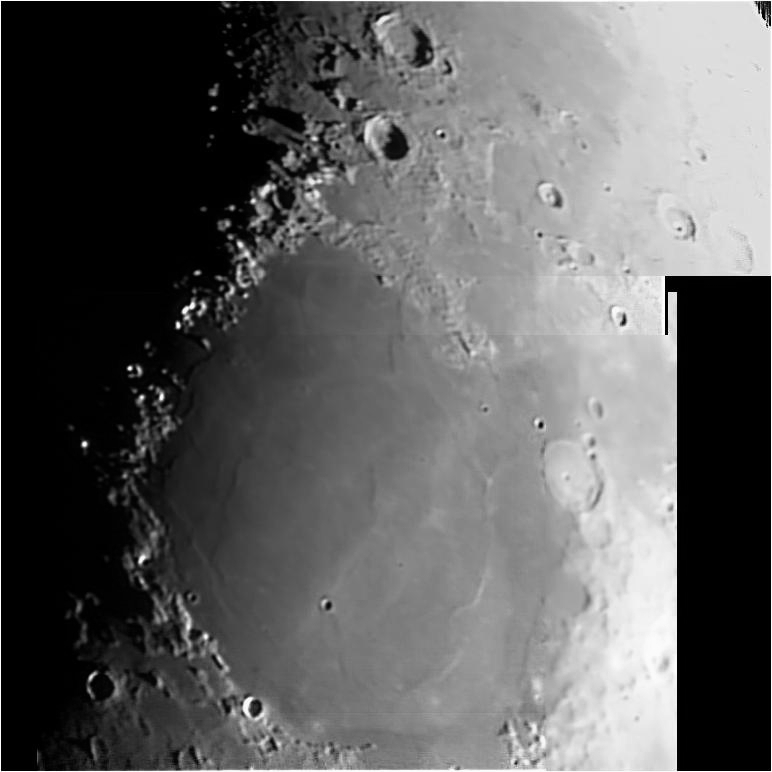
MARE SERENITATIS
2010.IV.20.1940 UT
* * *
Observation #153, 2010.III.22
Unlike last month when I was too late, this time I was only just too early to observe the Lunar optical event known as 'The Purbach "X"'. At a certain phase of the Moon around First Quarter, the intersecting high ridges between the craters Purbach, La Caille, and Blanchinus are illuminated by Sunlight before the lower-lying ground around them. The upshot is that in this region around this time of month a distinctive bright 'X'-shape is visible beyond the terminator, which gives the event its name.
1939 UT
Good view of the Moon at ×20 magnification with three or four nearby stars in the field of view including 118 Tauri, which it seems had just been occulted by the Moon. The Earthshine was a particularly outstanding beautiful one tonight, even through the telescope the colour was plainly a deep sensual blue, giving the unmistakable sense of the awe-inspiring sight of Earth's Atlantic Ocean seen from space, its vast expanse, its abysmal blue depth, the benign majesty of mother Earth seen as an alien planet, being reflected back at me by her little daughter-world. The Purbach 'X' was not quite fully-illuminated by the time the Moon was about to move out of view behind a house, but the X-shape was obvious. In spite of a power cut, I managed to take CCD images of the phenomenon until my laptop batteries ran out.
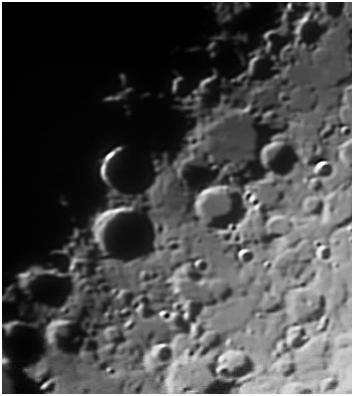
PURBACH 'X'
2010.III.22.2006 UT
The 'X' is behind the terminator left of top centre. It is not quite complete; the Sun was not quite high enough.
* * *
Observation #146, 2010.II.21
Whilst looking up features on a Lunar atlas in the afternoon, I realized that a Lunar feature I had wanted to see was possibly on view, the so-called 'Purbach "X"'. I say a feature, but the feature is rather more of an event. I quickly set up my 4" refractor and took CCD footage of the Moon in daylight. Unfortunately I was just too late to catch the full effect of the 'X's separation from the rest of the Moon, but nevertheless it still stands out.
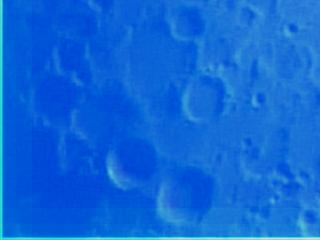
PURBACH 'X'
2010.II.21.1504 UT
Above is the original image which I managed to obtain in daylight through the blue of Earth's atmosphere.
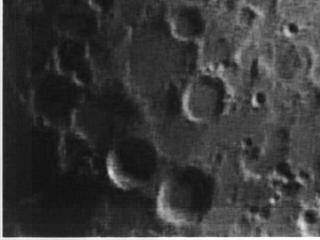
PURBACH 'X'
2010.II.21.1504 UT
Above is the original image processed to make the details stand out. The following image shows the Purbach 'X' feature ringed by a thick red circle, and names the surrounding craters.
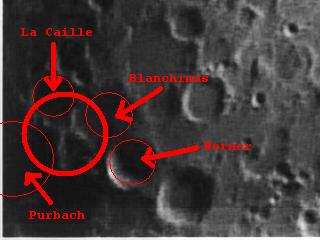
PURBACH 'X'
2010.II.21.1504 UT
Finally, the following image was taken in darkness four hours later, after the event was well and truly over, for the purpose of comparison.
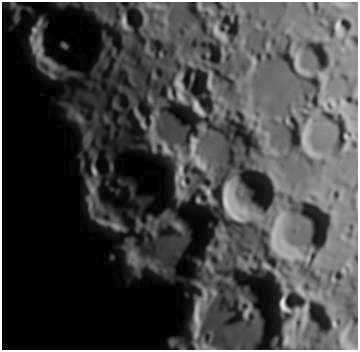
PURBACH AND ENVIRONS
2010.II.21.1926 UT
* * *
Observation #138, 2010.I.29
I had wanted to take an image of the Mare Orientale, as this will be invisible from Earth for a few months as the libration will be unfavourable. Could not see much of it, but then again no one ever can from Earth, nevertheless I still managed to capture an adequate montage of the southern limb of the Moon. South is top.
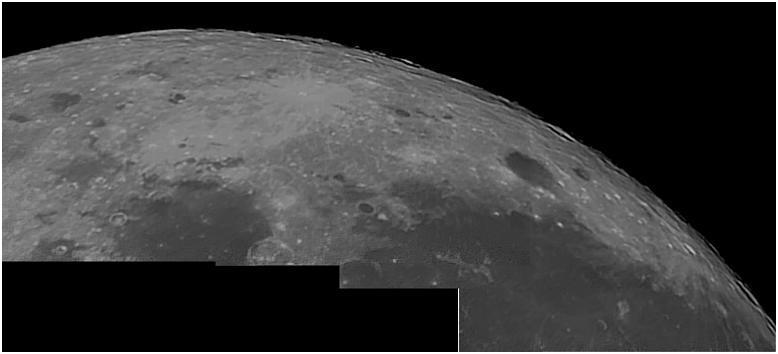
LUNAR SOUTHERN LIMB
2010.I.29.2313-2319 UT
* * *
Observation #132, 2009.XII.31
There was a partial eclipse of the Moon on the evening of the 31st, although from my location in Coventry I was clouded out for nearly all of it. Nevertheless I was able to watch through the occasional thin breaks in the cloud through binoculars, and saw enough to be able to make five fairly accurate drawings over the course of the eclipse. Of course, most people understand that a Lunar eclipse occurs when the Moon passes directly behind the Earth and the Earth is directly between the Moon and the Sun, casting her shadow over the Moon. What people don't realize perhaps is that the size and colour of the Earth's shadow vary due to atmospheric conditions on Earth, and the relationship between Earth's shadow and atmospheric conditions is not yet understood. Therefore the study of the nature of Earth's shadow during Lunar eclipses is another field in which amateur astronomers may contribute useful work.
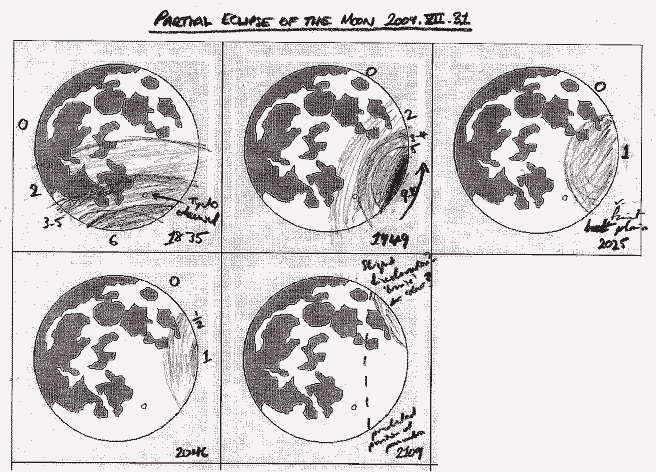
PARTIAL LUNAR ECLIPSE 2009.XII.31
The next Lunar eclipse will be on a partial eclipse on 26 June 2010 at 1130 GMT, not visible from my location in England. The next eclipse visible from where I am will be a total eclipse of the Moon before dawn on 21 December 2010, towards the winter solstice or longest night. This should be interesting if the weather is clear; the eclipse demonstrates the curvature of the Earth quite dramatically. The eclipse begins in complete darkness towards the end of the night with the Moon 22° above the horizon, totality begins two hours later at 0741 GMT with only half an hour before the Sun rises in the southeast, with the sky brightening blue all around and the Moon setting low in the northwest, and four minutes after the Sun rises the Moon sets, still in mid-eclipse. For those four minutes both Sun and Moon are visible above opposite ends of the horizon but the Moon is in total eclipse, with the Sun unable to shine past the ground rising from the southeastern dawn horizon to the observer, and falling to the northwestern horizon and the setting Moon, with the curvature of the Earth. These predictions are made possible with the help of a very useful little free DOS computer program which I downloaded from the British Astronomical Association Lunar Section, and which is available on my Downloads webpage.
At the end of the December 31st partial eclipse, I turned my 4" object glass on the Moon. Although the Earth's shadow was no longer visible on the Moon's disc, prior to ending observations I decided to look for the Mare Orientale region, a far side Lunar sea which can sometimes be seen at the edge of the Moon. As I did so I noticed a massive mountain peak in the region of Lacus Autumni, right on the edge of the disc, and set up the CCD to take an image of it.
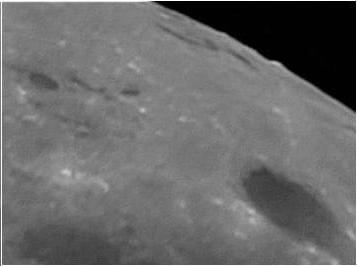
LUNAR LIMB NEAR LACUS AUTUMNI
2009.XII.31.2215 UT
* * *
Observation #123A, 2009.XII.5
0404 UT
Having been raining all evening, the weather unexpectedly cleared and I quickly set up my 8" specular.
0459
With the telescope still not properly cooled to outdoor air temperature, observed stunning (I said: 'stunning'; that's the sort of word cheap telescope salesmen use to describe the often disappointing views through their instruments) detail along the terminator in the region of Mare Crisium using 67.5mm aperture (the width of the lid of the plastic box of powdered milk I installed in the aperture cover) at ×160 and then again at ×400 magnification with the Wratten #80A Blue filter. My attention was drawn to an odd feature on the eastern border of Geminus E, next to a striking gorge to the south. East is top:
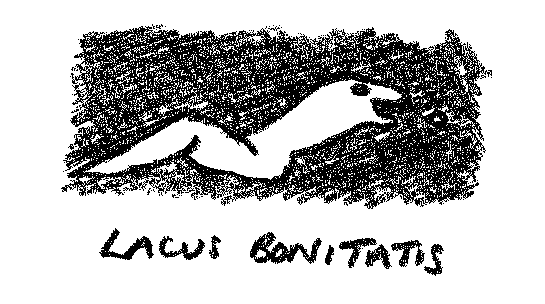
EASTERN BORDER OF GEMINUS E 2 DAYS 21˝ HOURS AFTER FULL MOON
2009.XII.5.0459-0504 UT
0504
Unfortunately, cloud cover returned before I had finished drawing the beast. The cloud quickly thickened and it looked like raining, but cleared enough by 0555 for me to take CCD footage through a hazy break in the cloud. Again, east is top.
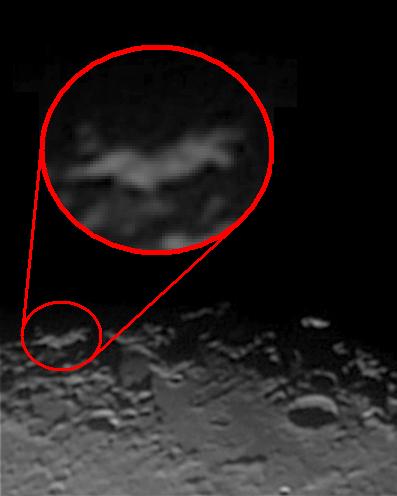
EASTERN BORDER OF GEMINUS E
2 DAYS 22˝ HOURS AFTER FULL MOON
2009.XII.5.0602 UT
This was the best image I could make out of what footage I took. Somewhat reminiscent of the blurred shaky photographs of the Loch Ness Monster that used to do the rounds in the late 1970s I would say. I would even dare venture that the feature should be named 'The Lacus Bonitatis Monster', after the Lacus Bonitatis which is the nearest Lake feature to Geminus E. 'The Lacus Bonitatis Monster' may be best observed three days less three hours after Full Moon, on the eastern border of Geminus E, about eighty miles north of the crater Macrobius.
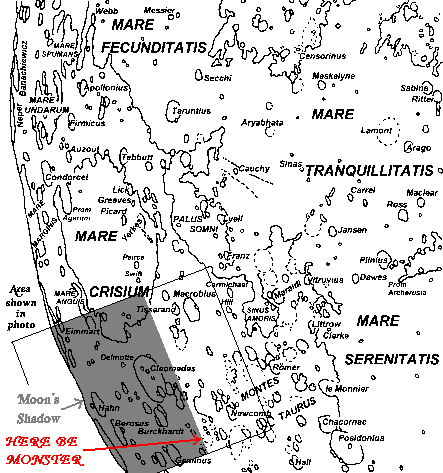
This is a map showing the position of The Monster. South is top. Perhaps The Monster was catapulted to the Moon from the Earth millions of years ago by means of a massive underwater volcanic explosion. Or perhaps The Monster deliberately catapulted himself to the Moon from the Earth by means of a giant spring, possibly to look for Green Cheese. Possibly. Perhaps. Or something. Probably.
* * *
Observation #122, 2009.XII.4
Managed to take the 4" object glass up to 375× magnification on the Moon, and immediately picked out the central twin peaks of the crater Langrenus with their imposing shadows. The terraced walls of the crater also stand out in clarity. East is top.
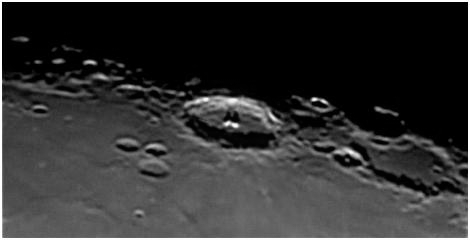
LANGRENUS
2009.XII.4.0227 UT
* * *
Observation #120, 2009.XI.26
1754 UT
Tried out the 4" refractor with CCD on the Moon for the second time, examining the south polar region and the walled plain Clavius, named after the sixteenth-century German mathematician, astronomer, and translator of the works of Euclid, Christoph Klau. North is top.
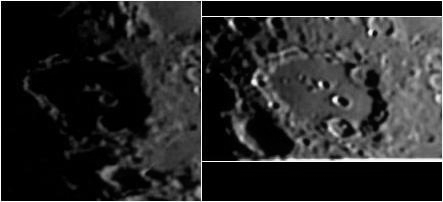
DAWN OVER CLAVIUS
2009.XI.25.1802 & 2009.XI.26.1815 UT
* * *
Observation #119, 2009.XI.25
1749 UT
With the Moon high in the south approaching first quarter, took the unmistakable opportunity to test my new 4" refractor, now neatly bolted on top of my old warhorse 8" reflector. Despite not having had enough time to cool the equipment to ambient temperature, despite lights on in all of the neighbours' houses, despite mist and the odd thin cloud, and despite the warm air from the cooling Earth at early evening causing major fluctuations in seeing, nevertheless the image was, though continually distorted by the seeing, the clearest I have ever seen. What is more I easily managed to get the smaller telescope up to ×250 magnification without losing definition; acquiring a refractor for planetary observation was obviously the right thing to do. I immediately set up the CCD camera and took some images, the most spectacular being a composite shot of the eastern Mare Imbrium. The Appeninus Mountains in particular are so clearly defined in this picture, that it looks as though the picture was taken from an aeroplane flying over them. The Moon looks like a familiar map of just another continent of Earth, only removed into space by a quarter of a million miles. North is top.
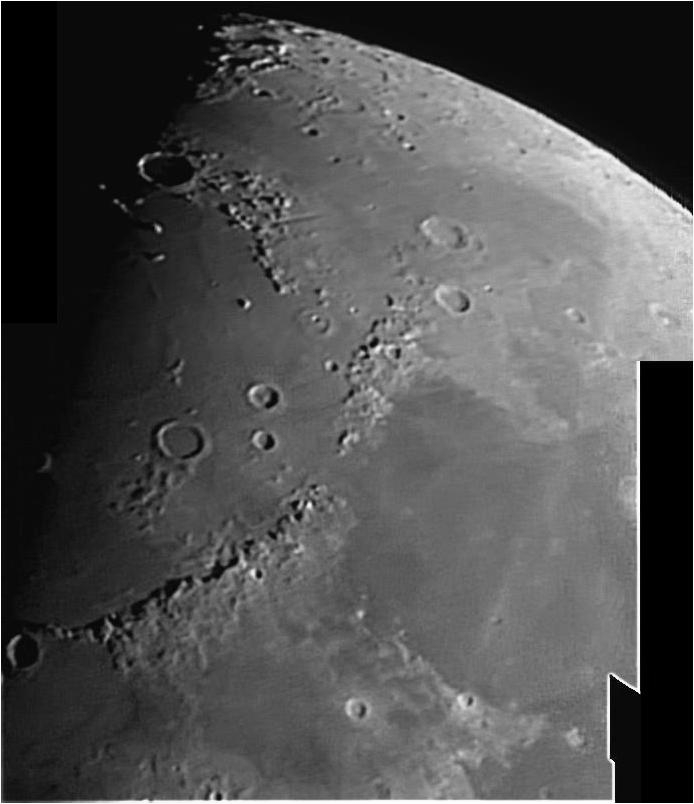
EASTERN MARE IMBRIUM
2009.XI.25.1751 UT
4" O.G., 2× Barlow, CCD camera with IR filter
This picture is not nearly as clear as what I saw at the telescope eyepiece, nevertheless, it's a fine picture. The straight dark grey line of the Vallis Alpes (Alpine Valley) which I have hitherto had difficulty seeing as clearly as I would like, is obvious in the Montes Alpes (Alpine Mountains), east of the dark-floored walled plain Plato at the terminator (Plato is the larger dark circular formation towards the north polar region where the Moon falls into shadow). The immense fault of the Vallis Alpes is eighty miles long and seven miles wide, with raised cliffs of unknown height on either side; I would make an unqualified guess of about 2,000 feet high. A fine rill runs along the floor of the valley; the rill is in fact half a mile wide, and of unknown depth. I can only imagine the awe-inspiring views that must be visible from inside this chasm, as the gigantic shadows of the adjacent cliffs creep up and down along the valley, slowly crawling down and along the northwestern cliffs from east to west, and across and out of the valley up the southeastern cliffs with the rising Sun, and then crawling down the northwestern cliffs again and back into the valley from the other side a fortnight later with the setting Sun. Or indeed during the fortnight-long night, when the northwestern cliffs must be lit up ghostly blue by Earthshine from the south, whilst the southeastern ones remain in darkness, casting their long black shadows looming into the bluish gloom. Or even, if the southeastern cliffs tower enough above the rill floor to blot out the Earth altogether, when the cliffs appear as nightmarish walls of impenetrable black, and with more stars visible overhead in their thousands, than can ever be seen from the bottom of Earth's atmosphere.
* * *
Observation #81, 2009.II.12
0100 UT
Fantastic adventures with Ross of London 8×30 1939-1945-issue British Army binoculars, simply pointing them through my grimy and condensation-streaked bedroom window at the Moon. There is so much to learn here. Finally I have memorized and become entirely familiar with the major naked-eye features of the Moon. In so doing, I have come to realize that there is much else that can be seen of the Moon through binoculars, once one sees her not merely as a whole, as a familiar face blown up eight times, but as separate named features whose individual natures are broadly understood: vast plains of lava, extensive mountain ranges, bright and dark craters. Through binoculars very many telescopic features stand out in clarity.
0153
Could only observe the Moon from the left edge of the window by this time, or else the house next door would be in the way. Watched the motion of the Earth's rotation take the edge of the house next door onto the right of the Moon's disc. Eerie. Over the following seconds watched the edge of the house move slowly across the Moon, becoming entirely aware of my position standing on a rotating, moving platform carrying me, the house next door, and everything else in the land, around with it. Felt slightly unsteady, exactly like being on a boat. This gigantic spaceship Earth.
0155
Moon now entirely invisible after only two minutes. That makes sense; the Moon appears roughly half a degree across from my location, I've just seen her move that distance in two minutes, and the entire 360° sky goes right round in 24 hours. Obviously. Do the maths.
* * *
Observation #70, 2009.I.14
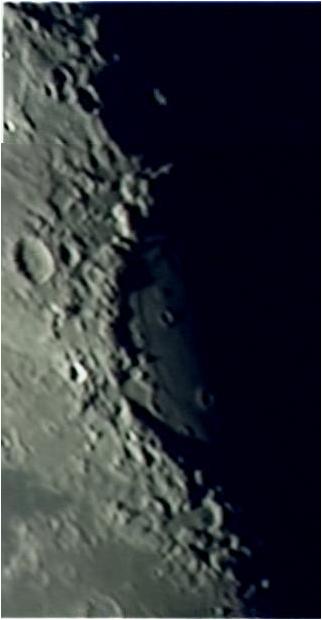
WESTERN MARE CRISIUM AT SUNSET
2009.I.14.0237 UT
A nice composite shot of the Mare Crisium falling into darkness, although not crystal clear seeing. Notice the wrinkle ridge on the flat lava floor of the central plain, and the lengthening shadows of the mountains of the western wall to the left of it. Also at the top of the picture, the eastern wall of the walled plain Cleomedes can be seen detached from the rest of the Moon, as the last dying rays of the Sun catch its tallest peaks. North is at the top of the picture.
* * *
Observation #69B, 2009.I.6
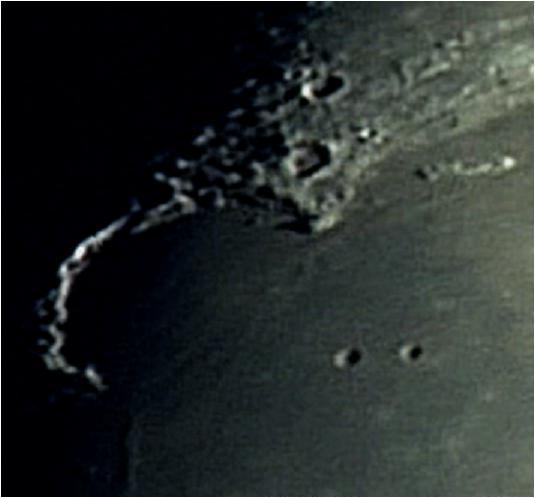
SINUS IRIDUM AT SUNRISE
2009.I.6.1740 UT
I had been wanting to see sunrise over the Bay of Rainbows for a long time, but what with the weather being so unpredictable I didn't bother predicting the event in advance, since in all likelihood I would be disappointed by adverse weather when the time came. In the event I caught the phenomenon purely by chance during the first clear shot at the Moon which I had seen for nearly a month. The larger tourist map below is aligned with (selenographic) north at the top, and shows the relative position of the Sinus Iridum (Bay of Rainbows) with the photograph of the Montes Appeninus (Appenine Mountains) further down this page.
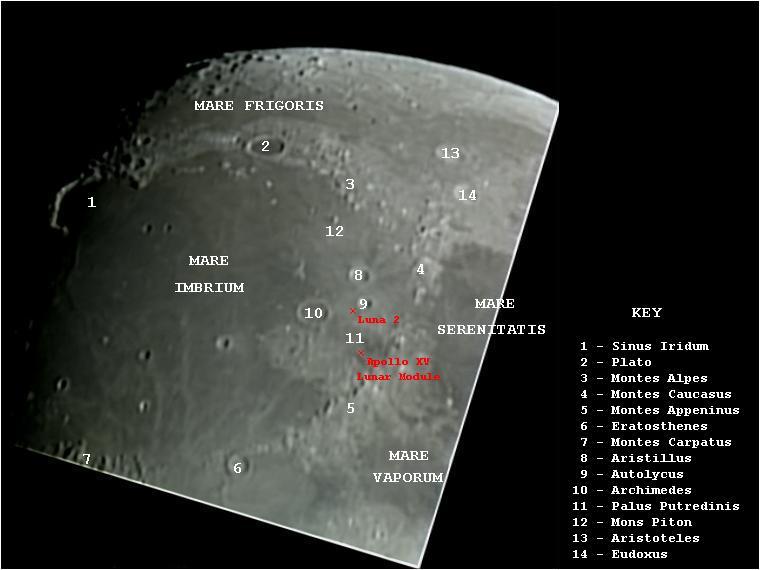
MARE IMBRIUM with SINUS IRIDUM AT SUNRISE
2009.I.6.2013 UT
* * *
Observation #54, 2008.XI.19
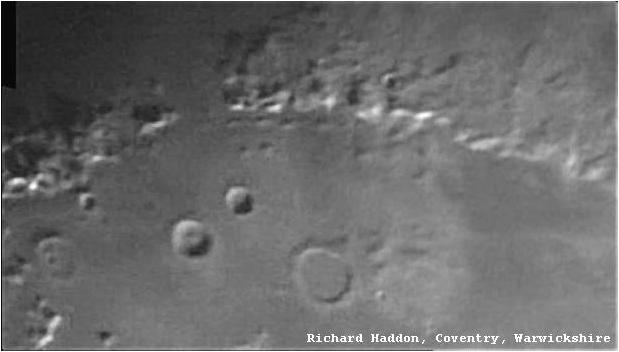
EASTERN MONTES APPENINUS AND VICINITY
2008.XI.19.0530 UT
A fine view of the eastern Appenine Mountains on the Moon, extending in from the right, with the Caucasus Mountains to the left, and the eastern Mare Imbrium underneath. East is top. The larger of the two dark craters is Aristillus, named after the third century BC Greek astronomer who lived in Alexandria. The crater is relatively young in selenological terms, being only about 1,000,000,000 (1 billion in American English, 1 milliard or one thousand million in British English) years old. In order to give some sense of scale here, Aristillus is about 33 miles across, and the highest peak in the centre of the crater is about 3,000 feet high. The smaller dark crater, Autolycus, lies directly due south of Aristillus, and is named after a fourth century BC Greek astronomer. About twenty miles westsouthwest of it is the impact site of Luna 2, the first man-made object to reach the Moon, in September 1959 (although you can't see it in this picture). The other largest crater forming a triangle with Aristillus and Autolycus is Archimedes, well over 3,000,000,000 years old and with a flat central plain of old lava. The dark area above this in the photograph is the Palus Putredinis, landing site of Apollo XV. At the end of the Appenines mountain chain is Mount Hadley, some 14,500 feet high. In the bottom left corner of the picture are the brightly lit peaks of the southern end of the Lunar Alps. To the right of these can be seen the isolated Mount Piton, some 6,800 feet high.
* * *
Observation #36, 2008.II.9
1810 UT
Clear night, seeing good. Antoniadi II. Waxing two-day-old crescent moon with unusually fine light grey Earthshine, setting in the west outside my window and looking like an obvious target.
In preparation for possible observations (weather permitting) of lunar eclipse on 21 February, observed thin crescent moon through 8×30 Army binoculars. Good crisp detail, Mare Crisium plainly evident at the terminator, the eastern wall enclosing the great 350-mile-wide plain already sunlit and extending beyond the terminator, with most of the plain still in shadow before it. Some craters visible all along the crescent but very difficult to identify at this low magnification. Scott crater partly in shadow towards the south pole most obvious (at least I think it was the crater Scott, it was difficult to tell - it could have been the neighbouring crater Demonax, which incidentally is named after a second century BC Greek philosopher). But the prize was the dark side of the Moon, illuminated by beautiful luminous Earthshine, best I've ever seen. Major discovery was that through binocs the Earthshine is seen to be faintly blue and not grey. Main Lunar maria murkily visible through this faint and strange ethereal blue glow of reflected light from the Earth. From the point on the Moon facing me the Earth must appear almost full and waning, the Americas in the middle of the disc basking in early afternoon sunshine, the eastern Pacific in morning to the west, and night falling over the Atlantic in the east. Highly inspiring.
The Moon has a tendency to fire people's imaginations in a bewilderingly quixotic manner that is difficult to verbalize, and which deserves careful consideration. Standing here on Earth seeing blue Earthlight on the dark side of the Moon is almost like seeing the Earth from the Moon, or more like seeing the Earth reflected in a gigantic mirror hanging in space. And then again one considers what people would think about the Earth had humans evolved on the Moon instead. Living in a desolate grey world, I don't think that the hopeless romance of having something as uniquely beautiful and colourful as the Earth hanging in the sky, apparently forever just out of reach, would be bearable for even one moment. We'd have to go there as soon as possible, and make that quest the whole object and ambition of human existence until it was achieved, whatever the effort, whatever the risk, whatever the pointlessness of the final result. After the Moon and the Sun, the Earth would be the centre of our Universe, of our religious faith, and the object of all quixotic longing, our inevitable destination. On the Moon one sings love songs about the Earth. Had we evolved on the Moon we would have migrated to the Earth to the last man. And here we all are so.
Theoretically relocating the origin of life to other worlds, removing the centre of the mundane Universe of the day-to-day drudgery of Earthly existence to the Moon for instance, returns us to the ancient conflict between blind religious faith in the Earth-centric Ptolemaic universe (which dogma arguably set back human progress by well over a thousand years) and the observable scientific fact of the Sun-centred Copernican system (and indeed the facts of the Milky Way Galactic system and the tens of thousands of millions of other galactic systems now). The problem with contemporary popular perceptions of humankind's position in the cosmos, is that the well-known fact that the Earth orbits the inconceivably insignificant Sun, doesn't really preclude the Earth from being the centre of the entire Universe in terms of the Universe's purpose, at least not whilst Earth remains obviously alone in the Universe as a home to life. The dogma today - born of another more perennial dogma, viz. that there is nothing in the Universe relevant to Man that contemporary Man does not understand; just as it was for the Dark Ages or the Middle Ages, just so it is for the third millennium after Christ - is that although in these times it is commonly accepted that the Earth is not located at the centre of the Universe, nevertheless it is still not commonly accepted that the Earth is not and should not be the centre of all human - or indeed Divine - attention. It is suicidal to make the Earth and living on it the focus of all human ambition and strivings, as such strivings must ultimately be in vain. Mighty but tiny-brained dinosaurs ruled the Earth for millions of years in the certain knowledge that Earth was all that there was, before being almost entirely wiped out by a catastrophic impact from Outer Space one fine day. Such impacts will certainly occur again in future unless something evolves that can do something about them first. C'est un jour comme un autre...
Through 24× Naval Telescope (a cheap extending hand-held telescope, not actual military issue) the Earthshine is dark grey, almost invisible. Some internal reflection of moonlight and blurring of detail. Difficult to hold the telescope steady, impossible to make out the level of detail seen through binocs, although a larger image. Not as good as the binocs at all really, although might be better if I could hold the thing still or mount it on something.
1837
Finally turned the 8" Newtonian reflector on the Moon, 40× magnification only, the lunar disc half-filling the entire view. Earthshine looked grey again. Took some mobile phone footage. Some faint stars still visible around the Moon, but the Moon would have been too low over the horizon behind trees etc. to observe them being occulted by the Moon. By precisely checking the times of such occultations, the Moon's position against the background stars can be calculated to within two or three hundred yards. Also stars which graze the Moon can wink in and out of view as they duck behind mountains, giving a profile of the lunar horizon at a given altitude. (Usually teams of observers occupy a field, at a fixed distance of a few yards apart from each other, to observe these events, thus giving a full profile of the Lunar horizon.) Also some multiple star systems that were previously thought to have been single stars have been discovered, by virtue of the fact that they were seen to flicker as the Moon passed in front of them, rather than wink out instantaneously as is usual. Next occultation I might possibly observe is of HIP13152, soon after 1955 UT on 11 March, with the Moon setting in the west.
1901
Moon dipping behind a treetop about a hundred yards in the distance, twigs showing up superimposed on the image.
* * *
Observation #3, 2006.VI.1
2217 (BST) [At this stage I did not realize that in timing astronomical observations, no matter where in the world or indeed the universe you are observing from, the convention is to quote all times in Universal Time (UT), and not in local time. UT is the same as GMT (Greenwich Mean Time) which is one hour behind the local British Summer Time (BST) which I am using here.]
I felt an inexplicable irrational dread come over me as I first angled the telescope towards the Moon. I was literally afraid to look through the eyepiece, as if I was going to see someone I didn't expect to see looking straight back at me. I even removed the eyepiece and fitted the (useless) green Moon filter in case the Moon hurts my eyes. I call this 'spider hanging over the aperture syndrome'; from Hergé's The Adventures of Tintin. In one of the Adventures (The Shooting Star) Tintin looks at an approaching meteorite through an observatory telescope, and sees a gigantic spider silhouetted against it and almost has a heart attack on the spot. The resident astronomer can't understand it when Tintin starts gabbling on about how terrifying the meteorite is with its horrible hairy legs, until he looks for himself and his assistant discovers a tiny spider crawling across the objective lens. And I had to clear a strand of spider web from across one of the apertures when I first set up this instrument. I quickly overcame these last hidden vestiges of my childish fears (which I never knew I still possessed) and automatically went through the motions of pointing the telescope without thinking. I was presented with my first ever close-up views of the Moon, which even with the green filter did not disappoint. At ×40 the Moon filled the view, spectacular vistas instantly obtained. Vast plains, colossal ridges and mountain ranges casting shadows, incredible detail in dark craters at the edge of the crescent as the Moon fell into shadow. All too much to take in at once; I hastily changed lenses rather than take detailed observations. At ×80 could only fit about half of the Moon into the field of vision. New details emerged, hundreds of tiny craters, impossible for me to make observations at this stage. To think that people have painstakingly mapped the entire surface like this. I found myself simply enjoying the spectacular views like a tourist, I didn't have time for anything else. Finally I removed the green filter and the image was even clearer, the Moon's natural colour producing a sense of remoteness and desolation - and almost of coolly patient expectation - that the green filter had completely barred. Looking up on a map of the Moon some of the features that I did have time to note down, I saw that I had merely picked out the obvious Maria: Serenitatis, Crisium, Tranquillitatis and Nectaris. In the vicinity of the Mare Nectaris I noted the crater Theophilus, on the edge of the Moon's own shadow, whose eastern ridge cast a deep dark shadow that made it seem very pronounced indeed. I also noted the Altai Scarp.
It's probably best if you return to the index page once you're done here.